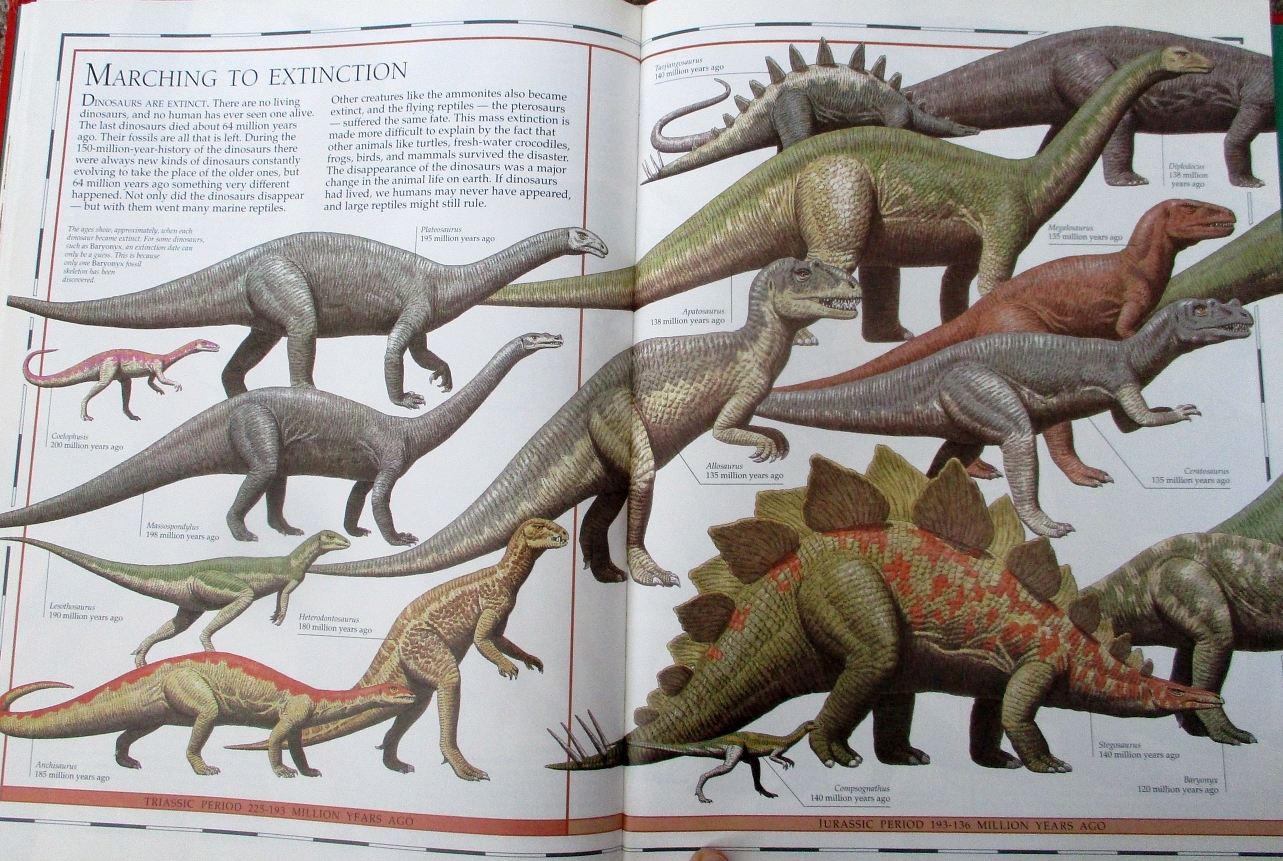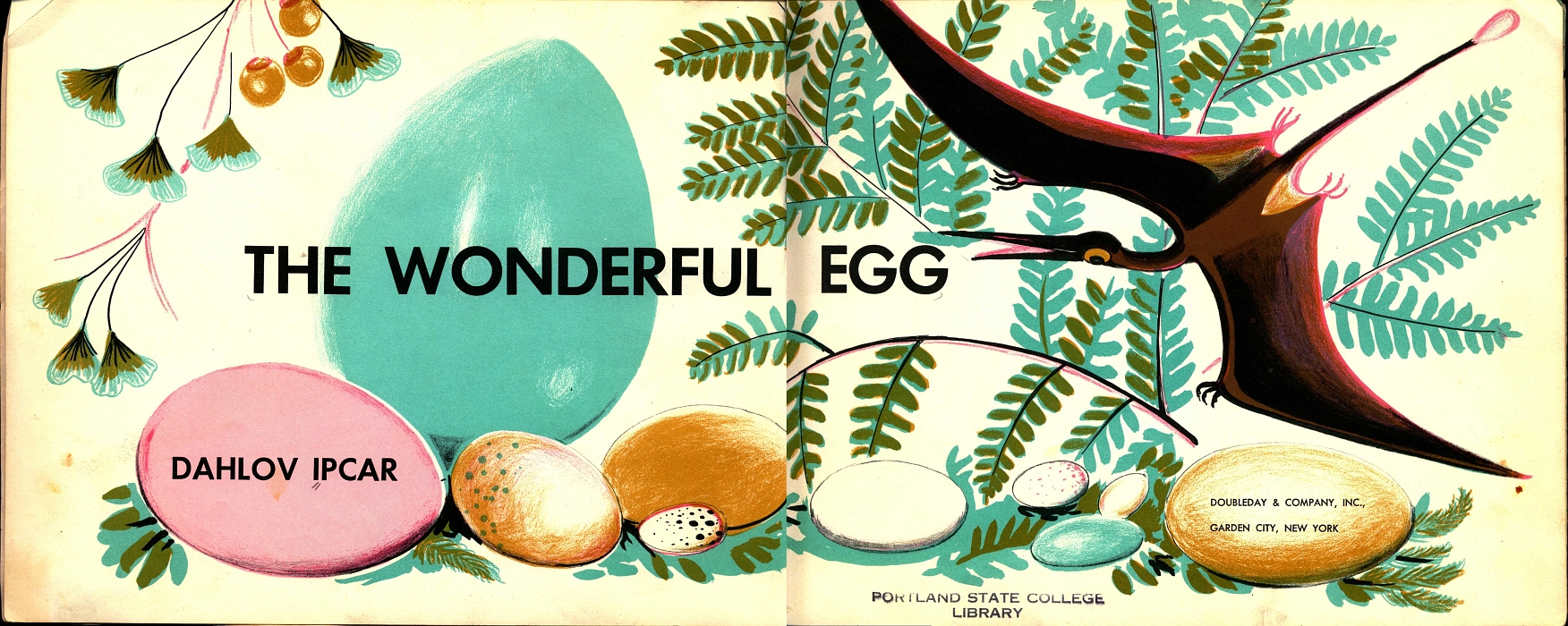Right, it’s time for one last round of The Great Dinosaur Atlas (see part 1 and part 2), the greatest book that John Sibbick ever illustrated by proxy. Again, I must apologise for using (dodgy) photographs rather than scans, but the book is so Great that squeezing it under my scanner is an issue. At least we’re able to fully appreciate such double-page spreads as…

…this stegosaur page, featuring the skeleton of Toujiangosaurus as it is mounted (as a cast) in London’s Natural History Museum. Dorling Kindersley must have had a decent range of photos of this mount back in the day, as it also formed the basis of a card model included in their ACTION PACK. (Incidentally, the ACTION PACK also recycled a number of illustrations from this book.) A perfectly well-executed illustration, and the inclusion of the child on a tricycle is a nice little whimsical touch (he’s a wee bit undersized, and so presumably just there for fun). A detailed study of the hand from a different angle is also thrown in, which is certainly interesting, although it appears to be a rather different hand. The life reconstructions, meanwhile, are, well, Sibbickian. Moving on…

Although it’s not as striking to modern eyes as the alarmingly dinosaur-sparse map of East Asia, the above plotting of African discoveries omits many species that would be considered de rigueur nowadays. Madagascar – now known to be home to a range of wacky dinosaurs – is completely missing, the space being given instead to an illustration of Giraffatitan‘s skeleton (which, in fairness, is an excellent use of any space on paper). No Carcharodontosaurus leering toothily at the reader, either. Of course, one is obliged to comment on the very of-its-time Spinosaurus, complete with Stromer-inspired four-fingered hands, a generic carnosaur head and the skin from a 1990s dinosaur toy. Wonderful.
The other life reconstructions here are obviously Sibbick-inspired, down to specific colour choices and poses. I don’t remember seeing Heterodontosaurus wearing any colour other than brown back in the early ’90s.

Now, this book may be The Great DINOSAUR Atlas, but it would hardly be complete without some otherprehistoricanimals thrown in to pad out the Mesozoic world. This cast of characters includes some very familiar-looking marine reptiles. When I did a little bit of livestreaming on Facebook related to this book, I had to admit that I wasn’t sure of the source. Happily, Darren Naish (the very same) was on hand to point out that they are based on Steve Kirk’s work for the Macmillan Illustrated Encyclopedia of Dinosaurs and Prehistoric Animals (hey, I don’t believe we’ve covered that one!). Fornari definitely wasn’t the only person to copy those illustrations – I’ve certainly seen the Peloneustes and Shonisaurus pop up elsewhere.
I do like the paving-like pattern on the Elasmosaurus, and when was the last time you saw Macroplata in a book like this? Although both may have ben lifted from the Macmillan book; I’m not that familar with the source material. Moving swiftly on, again…

Pterosaurs, of course, constitute the other otherprehistoricanimals that must be included in a popular dinosaur book. Again, during the Facebook stream I had to confess that I wasn’t sure of the source of these – Sibbick was mentioned, which does seem very likely, given everything else on show here. (That pterosaur encyclopedia is another book I really need to get hold of.) These are, at least, pretty good for the time – they all have pteroid bones and fuzz and aren’t emaciated, although the Pteranodon‘s green colour is rather peculiar. The reconstruction of Quetzalcoatlus is also interesting, coming as it does from a time after the ‘nightmare pin-headed demon’ phase, but before azhdarchids were very well understood; I don’t remember Sibbick’s ever looking like this (I only recall his much-copied version with a red head nubbin), so would love to know the source.
None of these reconstructions resemble nightmarish abominations, which is good, although it does rob me of the chance to make unwelcome political jokes that alienate a section of the readership. Shame.

The book closes, as so many popular books of this era seem to, with a March To Extinction.One is immediately given the image of a horde of giant reptiles shuffling witlessly toward their inevitable doom, akin to the trudging behemoths marching through the desert in Fantasia. The illustrations seem to reinforce this concept, with many of the animals depicted in an oddly retro, tail-dragging guise (sometimes based on a Normanpedia counterpart, and sometimes not). Again, they remind me a great deal of early ’90s dinosaur toys, although there’s a good chance that a number of those were based on Fornari’s work (as well as Sibbick’s). Stegosaurus is a head-drooping dullard, Allosaurus is a tripod, and Diplodocus is a sausage.

The March To Extinction progresses into the Cretaceous and finishes with the likes of Tyrannosaurus, Pachycephalosaurus and, er, Dravidosaurus (wait, what?). Poor old Rexy is forced to face the solid orangey-brown line that marks the final end of the dinosaur lineage. In the lower right, we see how the dinosaurs’ “place as rulers of the world was taken over by the mammals”, complete with an illustration of just such a stinkin’ mammal grinning away and twitching its whiskers like a rat-faced little git.
This approach does seem to echo earlier, pre-Dino Renaissance books, rather than presenting dinosaurs as being a highly successful group of animals. Admittedly, it’s not much more than echo, and it certainly isn’t suggested that dinosaurs are failures per se. But it’s interesting to note how outmoded concepts continue to resonate through time.
Also, there’s no commitment to scale, so Deinonychus and Oviraptor are honkin’ giants.
And that’s enough of that. Coming up: a book sent to me by Herman Diaz that might have been looked at before here (briefly) a long time ago!







4 Comments
Timur Sivgin
May 28, 2020 at 5:55 pmIf you mean the 1991 Illustrated Encyclopedia of Pterosaurs by Peter Wellnhofer with illustrations by Sibbick, I do have that book. Maybe I could send you some scans if you want.
Mustafa Ahmed
May 30, 2020 at 8:42 pmwhile I don’t have the book, I came across World of the Dinosaurs on Iguanodon’s wikipedia page, written by one Michael Tweedie. If the source is anything to go by, it proposes its thumb spike of Ol’ Iggy was actually used to inject venom. Not making this up. You’d have a field day with it.
Mustafa Ahmed
May 30, 2020 at 8:46 pmHopefully you get a copy of it one day and review it, forgot to add.
Jonathan P Keay
June 6, 2020 at 9:35 amHey – just want to add: I own that very book: 1977 World of the Dinosaurs by Michael Tweedie. Marc: if you want me to scan the book (or at least the artwork – there are some gems in there) drop me a line via email. Would love you to do a review of it. That book has a special place in my heart: I was 5 years old and it was my Christmas present in 1982!